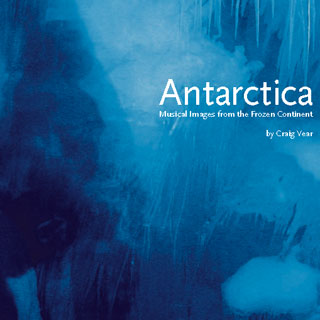Antarctica: Musical Images from the Frozen Continent. CRAIG VEAR
(Gruenrekorder 2012)
Antarctica: Musical Images from the Frozen Continent is a fine thing to have in your possession. This dvd/book/cd release by Craig Vear is jam-packed with goodies, from field recordings to radio works to still images to musical compositions and archival footage. Vear’s page at Gruenrekorder lists the contents in full.
In this review I’ve chosen to focus on the field recordings, presented on audio cd, though I’ll also offer reflection on the music of 5 Antarctic Solitudes.
The first thing that struck me about the field recordings is that they’re all captured by means of condenser microphones, that is, no hydrophones or contact microphones in sight. It surprises me slightly because ever more field recordists are working in remote natural environments with a range of microphones and high-end recording devices, widening the scope and conceptual range of what we might consider to be conventional ‘nature recording’. Although Vear was working in 2003/4, not so long ago, we can see how the topography of field recording’s ‘political economy’ has changed between then and now, Now we have the financial might and reach of influential media institutions like the BBC attempting to spearhead the field, alongside scientific enterprises in which artists have access to multi-channel hydrophonic arrays to the tune of tens of thousands of pounds. All things considered, Craig Vear has done very well with his (by today’s standards) modest resources.
The cd offers us six pieces, three recordings of penguins and sea mammals and three which focus on the sounds of sea, ice and water, with a hint of ‘pure’ ambience. I’ve never been to Antarctica, though I have a large map on my studio wall which I gaze at with longing and desire every day, but I have been to the Falklands and South Georgia and have sailed around the South Atlantic and I can tell you that the marine environment and the wildlife is utterly captivating. That and the fact that the constellations are upside down and the clouds seem to spiral in the wrong direction.
Vear’s approach is to plonk himself right in the middle of a heaving mass of snorting, farting, grunting, creaking and slabbering large seals, which, at times, if you didn’t know better, might be mistaken for certain species of primate. The penguins are hardly less restrained in their persistent chattering and fretting. For a ‘frozen continent’ the place is heaving with life and energy. One can only imagine the racket going on beneath the dark ever-changing surface of the southern oceans.
One piece captures the vessel James Clark Ross smashing through the sea ice. Here we can sense the danger as a metal hull, essentially your survival suit, enters into combat with the forces of nature at close quarter. There are interesting lulls between the crashes and rushes of ice and water – the unfolding sound field is dynamically unpredictable, with similar qualities to a fragile mountain bothy rattling in high winds and rain. Personally, I’d have taped a few contact mics to the hull to capture the effect of the stresses that the vessel was put under as it ploughed through the sea ice, but that doesn’t detract from a very fine recording.
The most intriguing of the six recordings is the last, entitled Glacial Melt Water and Moraine. Here I assume that we are on the actual land mass of the continent, right up against the body of the glacier. The listening environment is ambiguous, at times very gentle and restrained, but sounding also a note of tension. Although it ends with the most delicious wind flurries, it tends towards what I would call ‘pure’ ambience, most often captured at altitude, but which in this context will be the signature sound across most of the magnificent land mass. Call me perverse, but I’d like to listen to an hour or so of microphones placed right out in the vast snowfields on a very cold day.
The 5 Antarctic Solitudes are more ‘musical’ pieces, accompanying (or accompanied by?) archive footage of early Antarctic explorers and their dog teams carrying out their tasks in the very bleak black and white scratchy world of old film; hardy fellows to say the least. I could have watched the old films for hours.
Some of the pieces consisted of free and loose jazzy improvisation, Played by Vear and musical colleagues, lending a Chaplin-esque atmosphere to the film. Others made use of glitch and scratchy sounds, beats made of noisy blips and so on. Fashionable at the time (2003/4), these sounds are dated now, at least to my ears, such are the vagaries of fashionable sounds.
Finally, the History of Icelandic Music is a wonderful radio piece, in the broadest sense of the term, making use of narrative, field recordings and intriguing recordings of various Icelandic musical instruments – perhaps best described as a somewhat innovative work of ethnomusicology.
As I said at the beginning, this is a fine ‘objet d’art’ to have in your hands. I can seem myself dipping into it from time to time, glancing wistfully at my map of Antarctica and dreaming on the pure ambience of the frozen desert.
-Caity Kerr


